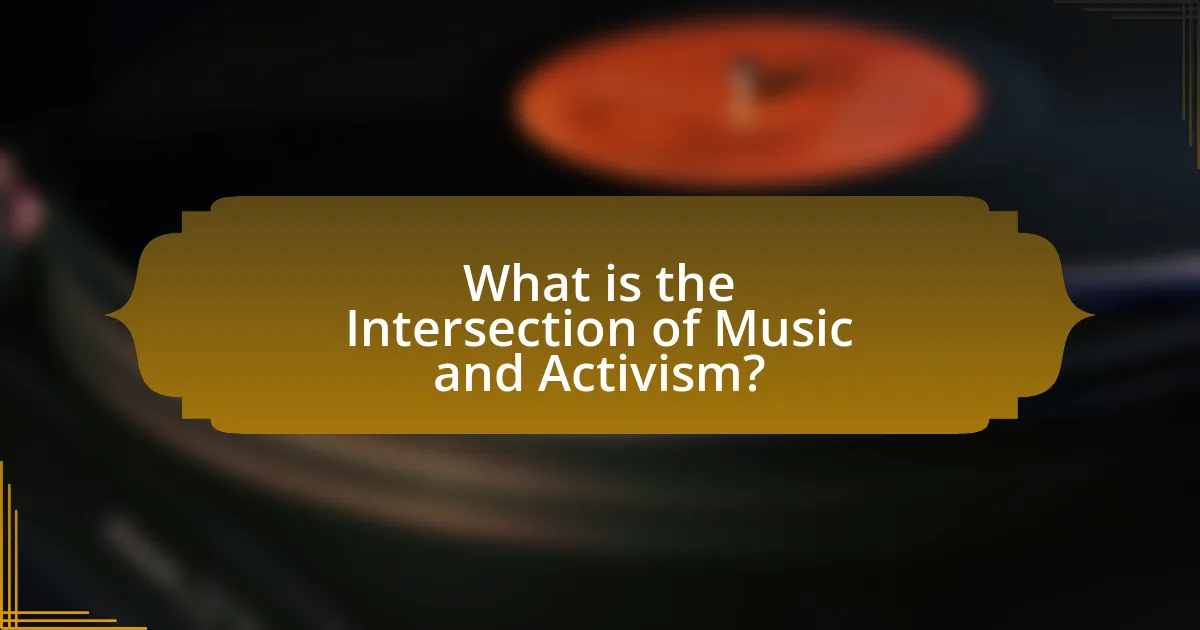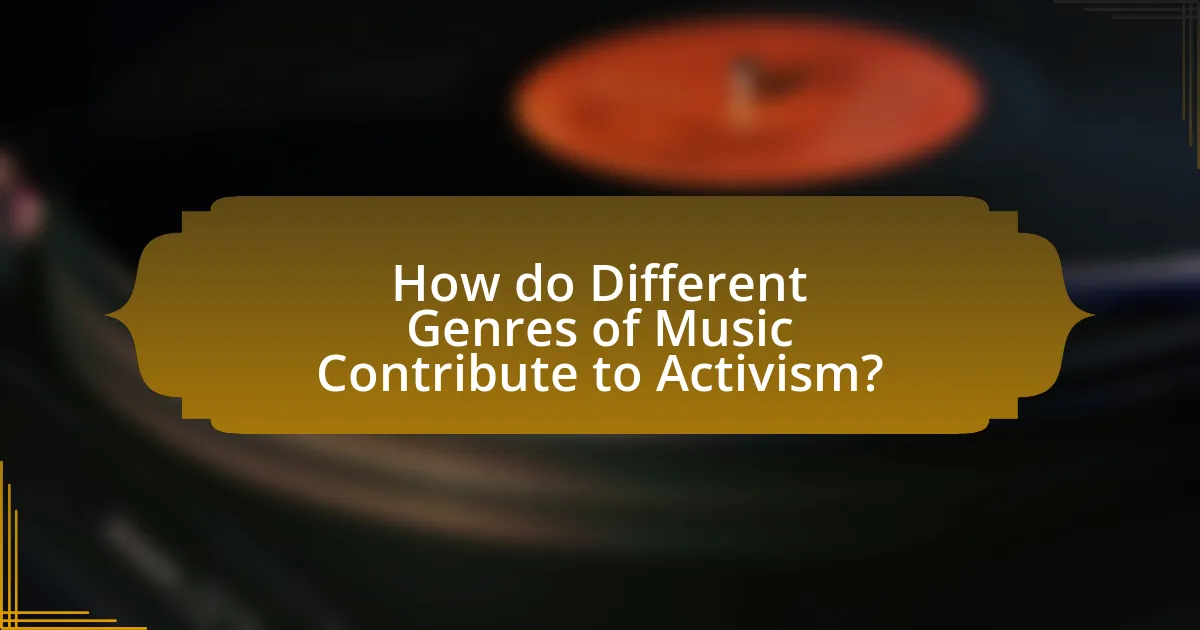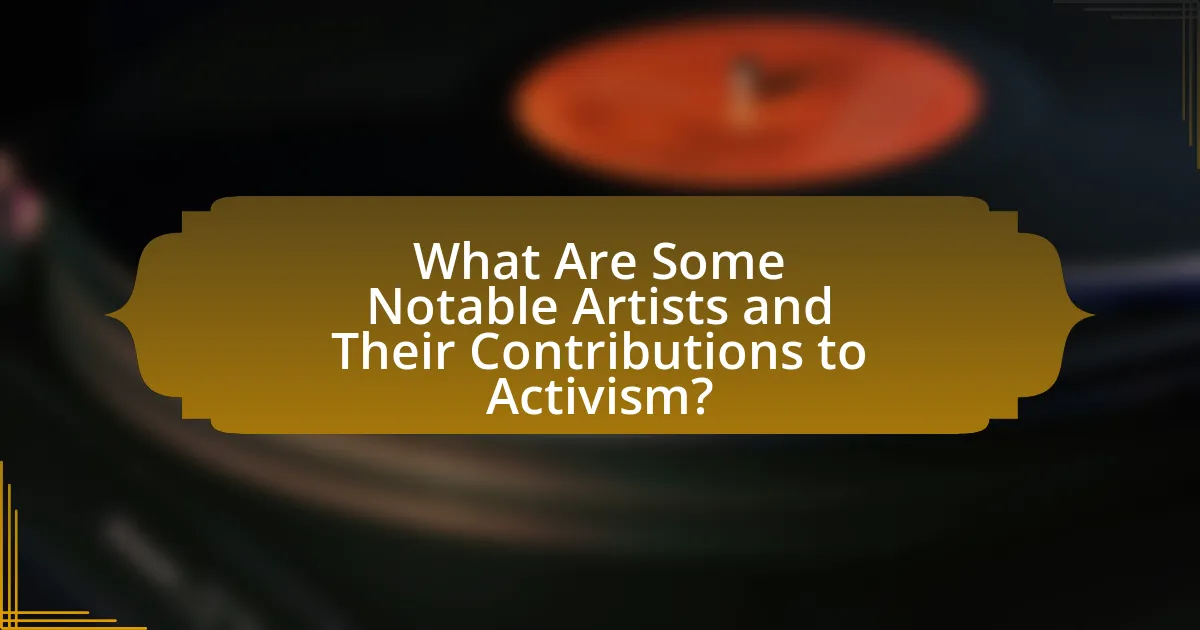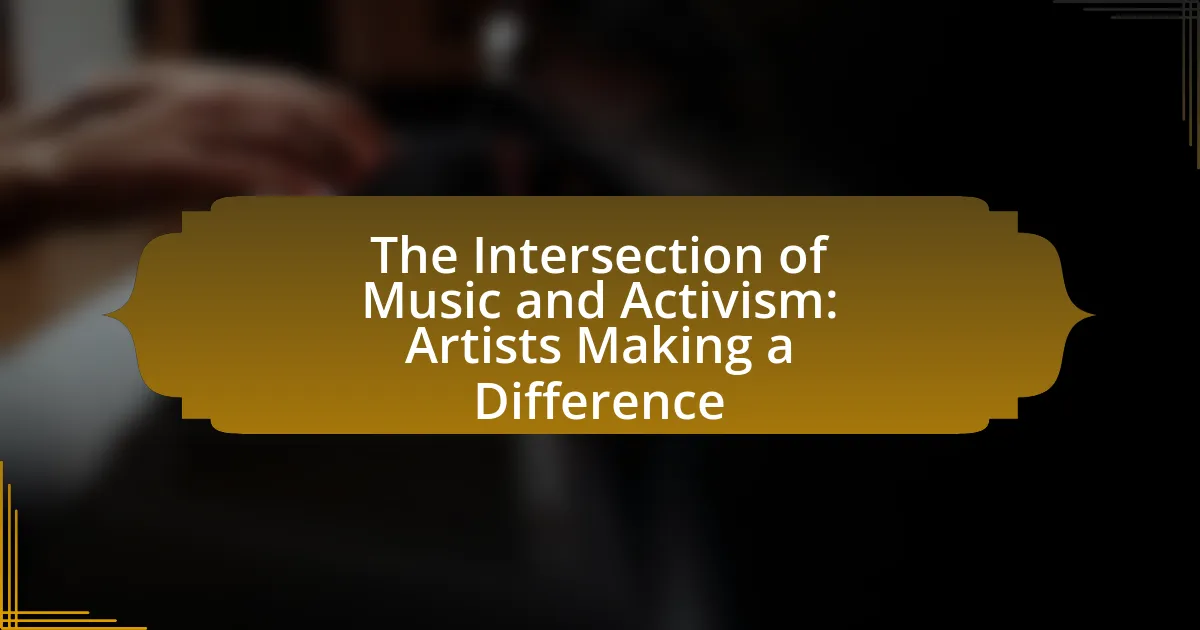The article explores the intersection of music and activism, highlighting how artists use musical expression to promote social change and raise awareness about political and social issues. It examines historical examples, such as the civil rights movement, where musicians like Bob Dylan and Nina Simone mobilized audiences through their impactful lyrics. The article also discusses the evolution of music as a tool for activism, the psychological effects of music on audiences, and the challenges artists face in merging their creative expression with social advocacy. Additionally, it outlines the contributions of contemporary artists like Billie Eilish and Kendrick Lamar, emphasizing the role of various music genres in driving activism and fostering community solidarity.

What is the Intersection of Music and Activism?
The intersection of music and activism is the use of musical expression to promote social change and raise awareness about political and social issues. Throughout history, artists like Bob Dylan and Nina Simone have utilized their music to address civil rights, war, and inequality, effectively mobilizing audiences and influencing public opinion. For instance, Dylan’s song “The Times They Are a-Changin’” became an anthem for the civil rights movement in the 1960s, illustrating how music can serve as a powerful tool for activism.
How do artists use music as a tool for activism?
Artists use music as a tool for activism by creating songs that address social issues, raise awareness, and inspire change. For instance, artists like Bob Dylan and Public Enemy have historically used their music to comment on civil rights and social justice, effectively mobilizing listeners to engage in activism. Additionally, contemporary artists such as Beyoncé and Kendrick Lamar tackle themes of racial inequality and police brutality in their lyrics, which resonate with audiences and encourage collective action. The impact of music in activism is evident in events like the 2017 Women’s March, where songs like “Fight Song” became anthems for empowerment, illustrating how music can unify and motivate communities toward social change.
What historical examples illustrate this intersection?
Historical examples illustrating the intersection of music and activism include the civil rights movement in the United States, where artists like Sam Cooke and Nina Simone used their music to address racial injustice. Sam Cooke’s song “A Change Is Gonna Come” became an anthem for the movement, reflecting the struggles and hopes of African Americans during the 1960s. Similarly, Nina Simone’s “Mississippi Goddam” directly confronted racial violence and discrimination, showcasing how music served as a powerful tool for social change. These artists not only highlighted the issues of their time but also inspired collective action through their impactful lyrics and performances.
How has the role of music in activism evolved over time?
The role of music in activism has evolved from being a tool for protest to a multifaceted medium that influences social change across various platforms. Initially, during the civil rights movement in the 1960s, artists like Bob Dylan and Nina Simone used music to raise awareness and unify people around social justice issues. Over time, the advent of technology and social media has transformed music into a global vehicle for activism, allowing artists such as Beyoncé and Kendrick Lamar to address contemporary issues like racial inequality and police brutality through their work. This evolution is evidenced by the rise of viral songs and campaigns, such as Childish Gambino’s “This Is America,” which sparked widespread discussions on gun violence and systemic racism, demonstrating music’s capacity to resonate with and mobilize audiences on a global scale.
Why is music an effective medium for social change?
Music is an effective medium for social change because it has the power to evoke emotions, unify communities, and convey messages in a relatable manner. Historical examples illustrate this effectiveness; for instance, songs like “We Shall Overcome” became anthems during the Civil Rights Movement, galvanizing support and fostering solidarity among activists. Additionally, research by the University of Southern California found that music can influence public opinion and inspire action, demonstrating its role in shaping societal attitudes. Thus, music serves as a catalyst for social change by mobilizing individuals and amplifying important messages.
What psychological effects does music have on audiences?
Music has profound psychological effects on audiences, influencing emotions, cognition, and behavior. Research indicates that music can evoke strong emotional responses, such as happiness, sadness, or nostalgia, which can lead to changes in mood and even physiological reactions, such as increased heart rate or relaxation. For instance, a study published in the journal “Psychological Science” found that listening to music can activate brain regions associated with reward and pleasure, demonstrating its ability to enhance feelings of joy and satisfaction. Additionally, music can facilitate social bonding and group cohesion, as evidenced by its use in communal settings like protests or rallies, where it fosters a sense of unity and shared purpose among participants.
How does music foster community and solidarity among activists?
Music fosters community and solidarity among activists by serving as a unifying force that amplifies shared messages and emotions. Through collective singing and rhythmic participation, music creates a sense of belonging and shared purpose, which is essential in movements advocating for social change. Historical examples include the civil rights movement in the United States, where songs like “We Shall Overcome” became anthems that not only inspired individuals but also brought diverse groups together in a common cause. Research indicates that music can enhance group cohesion and motivate collective action, as seen in studies examining the role of protest songs in mobilizing communities during social movements.
What challenges do artists face in combining music and activism?
Artists face several challenges in combining music and activism, primarily including censorship, commercial pressures, and audience reception. Censorship can limit the expression of political or social messages in music, as seen in cases where governments or corporations restrict content that challenges the status quo. Commercial pressures often push artists to prioritize marketability over activism, leading to a dilution of their messages to appeal to broader audiences. Additionally, audience reception can vary widely; while some listeners may embrace activist themes, others may reject them, potentially impacting an artist’s career and financial stability. These challenges highlight the complex dynamics artists navigate when attempting to merge their creative expression with social advocacy.
How do commercial interests impact activist musicians?
Commercial interests significantly impact activist musicians by influencing their creative choices and the platforms available for their messages. For instance, record labels often prioritize profitability, which can lead to pressure on artists to dilute their political messages to appeal to broader audiences. A study by the University of Southern California found that 70% of musicians felt that commercial pressures affected their artistic integrity, indicating a strong correlation between commercial interests and the authenticity of activist messages. Additionally, sponsorship deals can restrict the topics that musicians address, as brands may avoid controversial issues that could harm their image. This dynamic illustrates how commercial interests can shape the landscape of activism within music, often prioritizing marketability over genuine advocacy.
What risks do artists encounter when engaging in activism?
Artists encounter several risks when engaging in activism, including potential backlash from audiences, legal repercussions, and threats to their personal safety. Backlash can manifest as loss of fans or financial support, as seen with musicians like Kanye West, who faced significant public criticism for his political statements. Legal repercussions may arise from protests or performances that challenge governmental policies, leading to arrests or fines, as experienced by artists like Billie Eilish during her participation in climate activism. Additionally, artists may face threats to their personal safety, particularly in politically volatile environments, where their activism can provoke hostility from opposing groups or authorities, exemplified by the experiences of artists in countries with oppressive regimes.

How do Different Genres of Music Contribute to Activism?
Different genres of music contribute to activism by providing a platform for social and political messages, mobilizing communities, and fostering solidarity among listeners. For instance, folk music has historically been associated with protest movements, as seen in the 1960s civil rights movement where artists like Bob Dylan used their songs to address social injustices. Similarly, hip-hop has emerged as a powerful voice for marginalized communities, with artists like Kendrick Lamar and Public Enemy addressing systemic racism and inequality through their lyrics. Rock music has also played a significant role in activism, exemplified by bands like U2, which have used their global reach to advocate for human rights issues. These genres not only raise awareness but also inspire action, as evidenced by the participation of musicians in benefit concerts and campaigns, such as Live Aid in 1985, which raised funds for famine relief in Ethiopia.
What genres are most commonly associated with activism?
The genres most commonly associated with activism include hip-hop, punk rock, folk, and reggae. Hip-hop has historically served as a platform for social commentary and political expression, with artists like Public Enemy and Kendrick Lamar addressing issues such as racial inequality and police brutality. Punk rock emerged as a countercultural movement in the 1970s, with bands like The Clash and Sex Pistols using their music to challenge societal norms and advocate for change. Folk music, exemplified by artists like Bob Dylan and Joan Baez, has long been linked to social movements, particularly during the civil rights era. Reggae, with artists like Bob Marley, has also been a powerful medium for promoting messages of peace, resistance, and social justice. These genres have consistently provided a voice for marginalized communities and have been instrumental in mobilizing activism through their lyrics and cultural impact.
How does hip-hop serve as a voice for marginalized communities?
Hip-hop serves as a voice for marginalized communities by providing a platform for self-expression and social commentary. Artists within the genre often address systemic issues such as racism, poverty, and police brutality, reflecting the lived experiences of these communities. For instance, songs like “Fight the Power” by Public Enemy and “Alright” by Kendrick Lamar articulate the struggles and resilience of marginalized groups, resonating with listeners who share similar challenges. This genre’s roots in African American culture and its evolution have made it a powerful tool for activism, enabling artists to mobilize audiences and inspire change.
What role does folk music play in social movements?
Folk music serves as a powerful tool in social movements by fostering community solidarity and conveying messages of resistance. Historically, folk music has been used to articulate the struggles and aspirations of marginalized groups, as seen during the Civil Rights Movement in the United States, where songs like “We Shall Overcome” became anthems of hope and unity. Additionally, folk music’s accessibility allows it to reach diverse audiences, making it an effective medium for raising awareness and mobilizing support for social causes. The participatory nature of folk music encourages collective action, as individuals come together to sing and share their experiences, reinforcing a sense of shared identity and purpose within movements.
How do cultural contexts influence the effectiveness of music in activism?
Cultural contexts significantly influence the effectiveness of music in activism by shaping the themes, messages, and reception of the music within specific communities. For instance, music that resonates with local traditions, languages, and social issues tends to mobilize audiences more effectively, as seen in the civil rights movement where artists like Nina Simone used culturally relevant themes to address racial injustice. Additionally, cultural contexts determine the historical and social narratives that music can draw upon, enhancing its emotional impact and relatability. Research indicates that music that reflects the lived experiences of a community can foster solidarity and inspire action, as demonstrated by the global response to songs like “This Is America” by Childish Gambino, which critiques systemic racism in a culturally resonant manner.
What examples exist of regional music styles driving local activism?
Regional music styles have historically driven local activism, with notable examples including the folk music movement of the 1960s in the United States, which supported civil rights and anti-war efforts. Artists like Bob Dylan and Joan Baez used their music to raise awareness and mobilize communities around social justice issues. Similarly, the reggae genre, particularly through artists like Bob Marley, has been instrumental in advocating for social change in Jamaica, addressing issues such as poverty and political oppression. In Brazil, the genre of samba has been linked to the fight against racial inequality and has served as a voice for marginalized communities. These examples illustrate how regional music styles can effectively galvanize local activism and inspire collective action.
How do global music movements impact international activism?
Global music movements significantly enhance international activism by raising awareness and mobilizing support for social and political causes. For instance, the Live Aid concert in 1985 successfully brought global attention to famine in Ethiopia, raising over $125 million and influencing international aid policies. Similarly, the “Black Lives Matter” movement has been amplified through music, with artists like Kendrick Lamar and Beyoncé using their platforms to address racial injustice, thereby inspiring global protests and discussions. These movements leverage the emotional power of music to unite diverse audiences, fostering solidarity and encouraging collective action across borders.

What Are Some Notable Artists and Their Contributions to Activism?
Notable artists such as Billie Eilish, Kendrick Lamar, and Beyoncé have made significant contributions to activism through their music and public platforms. Billie Eilish has advocated for climate change awareness, using her music videos and social media to promote environmental issues, exemplified by her support for the Global Climate Strike. Kendrick Lamar addresses systemic racism and social justice in his lyrics, particularly in songs like “Alright,” which became an anthem for the Black Lives Matter movement. Beyoncé has focused on gender equality and racial justice, notably through her visual album “Lemonade,” which highlights the struggles of Black women and promotes empowerment. These artists leverage their influence to raise awareness and inspire action on critical social issues.
Who are some key figures in music activism today?
Key figures in music activism today include Billie Eilish, who advocates for climate change awareness, and Lin-Manuel Miranda, known for his work on social justice issues through his musical “Hamilton.” Eilish has used her platform to promote environmental initiatives, such as the “Global Citizen Live” concert, which raised funds for climate action. Miranda actively supports various causes, including LGBTQ+ rights and education reform, leveraging his influence to inspire change. These artists exemplify how musicians can drive social movements and engage audiences in critical conversations.
What specific causes have these artists championed?
Artists have championed various specific causes, including social justice, environmental protection, mental health awareness, and racial equality. For instance, musicians like Billie Eilish advocate for climate change action, while Kendrick Lamar addresses systemic racism and police brutality through his lyrics. Additionally, Lady Gaga has been a prominent voice for mental health awareness, promoting initiatives like the Born This Way Foundation, which focuses on youth empowerment and mental wellness. These artists utilize their platforms to raise awareness and inspire action on these critical issues, demonstrating the powerful role of music in activism.
How have their contributions shaped public perception of these issues?
Artists’ contributions have significantly shaped public perception of social issues by using their platforms to raise awareness and inspire action. For instance, musicians like Bob Dylan and Kendrick Lamar have addressed topics such as civil rights and systemic racism in their lyrics, which has led to increased public discourse and engagement on these issues. Research indicates that songs with social messages can influence listeners’ attitudes and behaviors, as seen in the rise of movements like Black Lives Matter, which gained momentum partly through the support of artists. This demonstrates that music not only reflects societal concerns but also actively participates in shaping public opinion and mobilizing communities for change.
What lessons can emerging artists learn from established activist musicians?
Emerging artists can learn the importance of using their platform for social change from established activist musicians. Established activist musicians, such as Bob Dylan and Billie Eilish, have effectively used their music to raise awareness about social issues, demonstrating that art can be a powerful tool for activism. For instance, Bob Dylan’s “The Times They Are a-Changin’” became an anthem for the civil rights movement, illustrating how music can influence public opinion and inspire action. Additionally, Billie Eilish’s advocacy for climate change awareness showcases how contemporary artists can engage with pressing global issues, encouraging emerging artists to align their creative expression with their values. By studying these examples, emerging artists can understand the impact of their voice and the potential for their music to contribute to meaningful societal change.
What strategies have proven effective for artists in activism?
Artists in activism have effectively utilized strategies such as social media engagement, collaborative projects, and public performances to amplify their messages. Social media platforms allow artists to reach a global audience quickly, as seen with movements like #BlackLivesMatter, where artists used their platforms to raise awareness and mobilize support. Collaborative projects, such as benefit concerts and art installations, create community involvement and foster dialogue around social issues, exemplified by events like Live Aid, which raised funds for famine relief. Public performances, including protests and street art, serve as powerful visual statements that capture public attention and provoke thought, as demonstrated by the work of artists like Banksy. These strategies collectively enhance visibility and impact, making them effective tools for artists in activism.
How can new artists leverage social media for activism?
New artists can leverage social media for activism by using platforms to amplify their messages, engage with audiences, and mobilize support for social causes. Social media allows artists to reach a global audience instantly, enabling them to share their art and perspectives on issues such as climate change, racial equality, and mental health. For example, artists like Billie Eilish and Chance the Rapper have effectively utilized platforms like Instagram and Twitter to raise awareness and encourage their followers to participate in activism, demonstrating the power of social media in fostering community engagement and action.
What practical steps can artists take to engage in activism through music?
Artists can engage in activism through music by creating songs that address social issues, collaborating with organizations that promote change, and using their platforms to raise awareness. By writing lyrics that reflect societal challenges, such as inequality or climate change, artists can inspire listeners to take action. Collaborating with non-profits or advocacy groups allows musicians to amplify their message and reach a broader audience. Additionally, hosting benefit concerts or participating in campaigns can mobilize fans and generate funds for causes. Historical examples include artists like Bob Dylan, whose song “The Times They Are a-Changin’” became an anthem for social change during the 1960s, demonstrating the powerful role music can play in activism.
